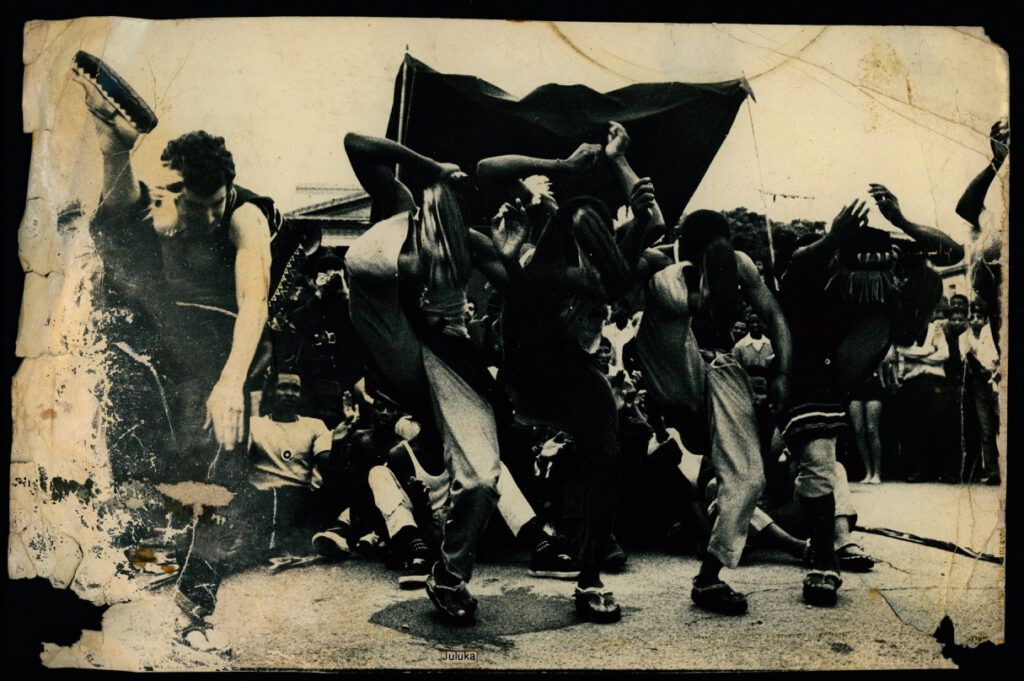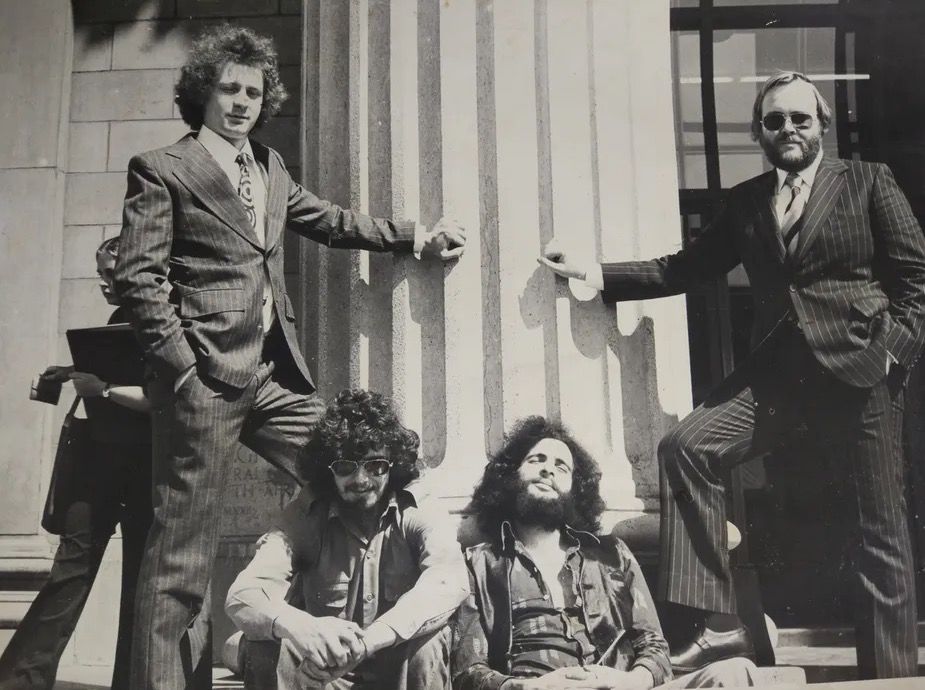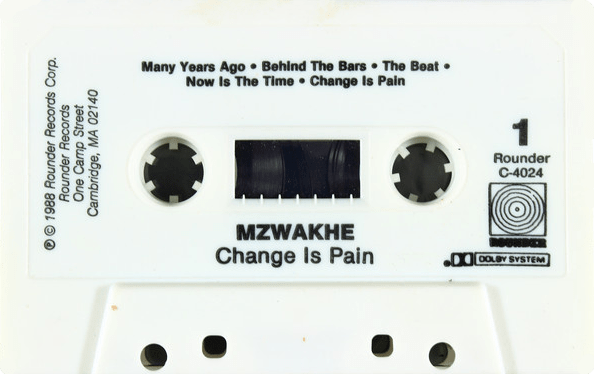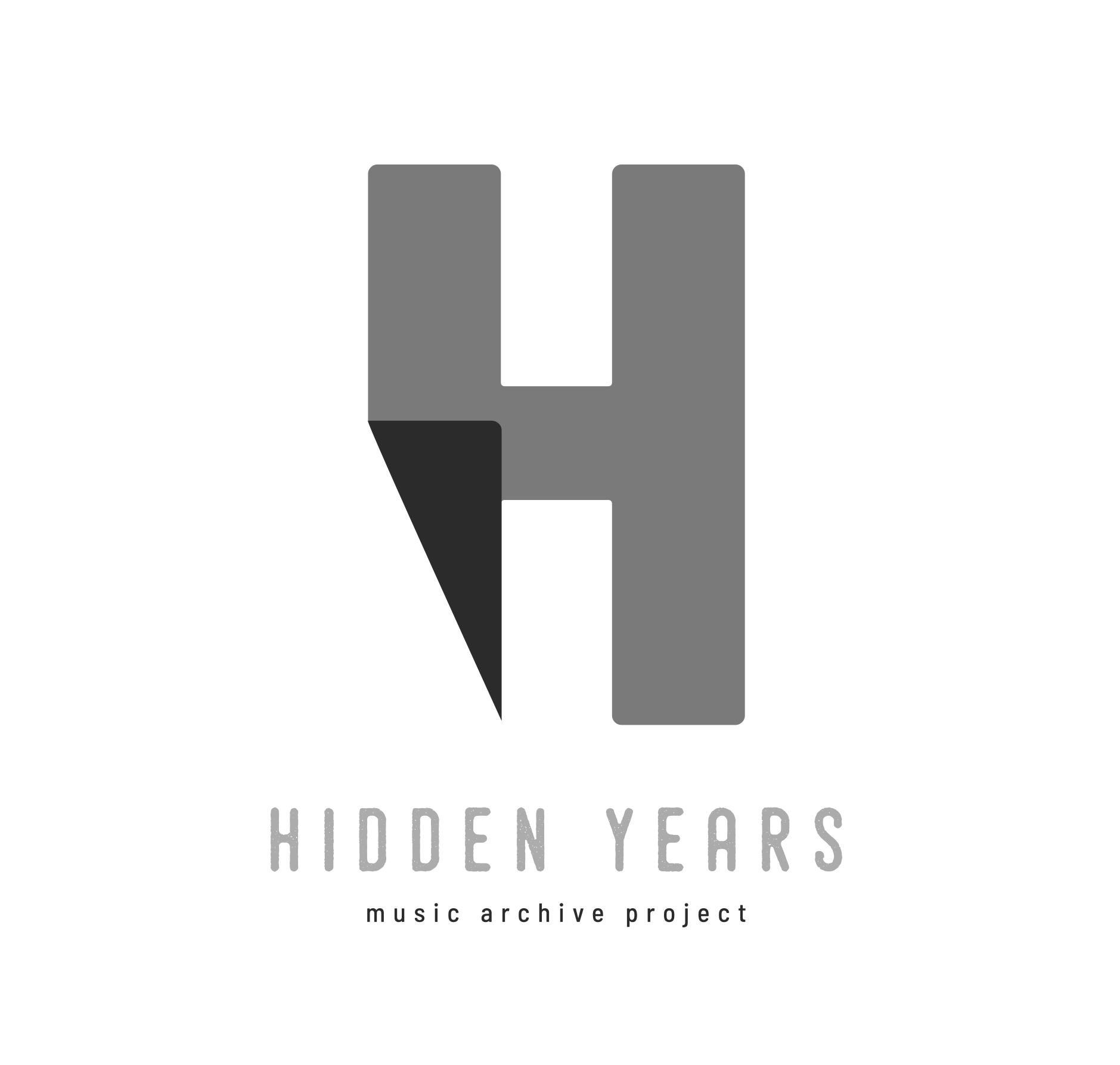DEREK DAVEY
Dodging the sjambok
In the late seventies, Dax Butler remained on the Market Theatre Café’s stage between sets while the rest of his band, called The Other Band, went outside for a joint. He played a song he had been working on that commented on the repressive Apartheid state:
Hygiene’s ancient capers
Wipe my ass with your newspapers
A battery of flattery and lies
Just about the size of the headlines
If you’re looking for Godot
Go on down to Soweto he’s waiting there …
forgetting that club owner David Marks was busy recording the whole set – and his progressive song.

The Market Café was, much like its owner, as visionary as it was eccentric. Malcolm Purkey, a former director of the Market Theatre, says the venue was filled with chairs of every description – including a dentist chair – and “would never have passed the safety standards that venues have to today”. It was a place where sound people could experiment with new systems, budding artists were nurtured, institutions, productions and careers were launched, and audiences could hear performers such as Malombo and Dollar Brand, frequently before they became famous.
Butler wasn’t a protest artist as such, but staying quiet about what was going on in South Africa at that time was difficult for any artist with a conscience: “The mood was completely different after the ’76 Soweto uprising,” he says. Marks had a habit of recording “anything that moved or murmured”, so it is likely that Butler’s song is somewhere in Marks’ Hidden Years Music Archive Project. This a vast collection of music, films, notebooks and photographs that is now being catalogued and archived in a mammoth undertaking – its 175 000 items weigh over seven tonnes – by Dr Lizabé Lambrechts and Pakama Ncume and their team at the Africa Open Institute for Music, Research and Innovation at Stellenbosch University.
A musician himself, Marks had attained notoriety with a couple of hit songs in the late 60s, most notably Master Jack, which helped to further his passion: recording, filming and providing platforms for South African musicians. The aim of his record company 3rd Ear Music was, according to its website, “to promote, produce, protect and publish local acts deemed non-commercial or too political”. A musician who helps other musicians, he’s not unique (think Ry Cooder and the Buena Vista Social Club) but in Apartheid South Africa, it was pretty much only musicians that kept the “indie” side of music alive.
The country was at this stage, as Master Jack describes it, “a very strange world”, where even listening to “different” music, let alone playing it, could land one in a whole heap of trouble. To get an idea of the oddness of the era, read about how some hippies at a “pop festival” were held down by some Afrikaans divinity students intent on “maintaining the moral order” and had their locks shaved off in South Africa’s very own Homer Lee Hunnicutt moment: The 1970 Kruger Day Hair Massacre.
Recording blues
To get a song or an album recorded in the 70s and 80s, before the advent of digital, was no mean feat. “Remember that back then recording wasn’t as easy as it is today; it was expensive and restricted,” says Deon Maas, who worked for Tusk and was a label manager for One World Entertainment. Today, musicians can record at home; back then they were at the mercy of commercial record companies. In South Africa, these companies almost never spent time and money developing local artists, preferring to promote international music that they believed was more likely to yield profits on their investments.
Local singers that sang anything vaguely derogatory about the Apartheid regime were even more unlikely to be promoted, but Ian Osrin, a former producer for Teal-Trutone, says if an artist had protest messages, they could be “disguised” in townships codes – lingos that only some could understand. For example, the song Love Target by the artist Zashaa was based on the practice of some township residents chanting “Targeti, targeti” as they stoned passing police cars, and had a hidden meaning that “the Teal executives were totally in the dark about”. Maas said that major record companies minimised the chances of getting controversial songs banned “by not printing the lyrics, or printing them very small, or in a difficult-to-read manner”.
While many artists struggled, some musical genres were selling well in South Africa, such as Gé Korsten’s Afrikaans tunes, which the Apartheid authorities considered “suitable”. Kwela, mbaqanga and isicathamiya (and later, hip-hop, kwaito and rap) were, at varying times, all huge. Marks says: “Black musicians were producing and selling records by the hundreds of thousands. The township and rural events that I was involved with – from the late 60’s to mid-1980’s – were massive. Black record producers were swanning around in Jaguars with bodyguards and bling …”
Many black artists, however, were ignorant of copyright law and were grossly exploited by record companies. They were paid in once-off session fees, or even, as maskande musician Philemon Zulu told me, taken to a general dealer store and told to fill a wheelbarrow with whatever they could find in lieu of being given cash. The most classic rip-off of all was that of Solomon Linda, whose song Mbube (later known as Wimoweh and When the Lion Sleeps) generated millions, of which Linda and his family obtained a mere pittance.
Western music flooded the South African market, and the big money went into paying local session musicians to cover foreign chart-toppers, perhaps most famously on the Springbok Hit Parade series. Finding somewhere to play original music wasn’t easy, says Butler: “Most venues wanted bands that played covers. Wits University was one of the few places where you could play original music.”

The Free Peoples Concerts
Butler got to play on another Marks platform with a band called Benny B’Funk and the sons of Gaddafi Barmitzvah. This was the Free Peoples Concert series, which started at Wits in 1971 (after one gig in Durban) and then expanded to run at various larger venues until 1986. Marks had worked with Bill Hanley doing sound at Woodstock in 1969 and brought back part of the PA, which came to be known as the “Woodstock bins”, and these warmed the ears of grateful festival audiences across southern Africa for decades. He was able to hold the Free Peoples Concerts by exploiting a loophole in an Apartheid law: if the event was free and the performers played for free, there could be no restriction on who attended.

These concerts provided a sense of what a different or “normal” society could be; and, because they brought black and white people together, they gave the authorities “the jitters”. Wits alumnus Shaun de Waal wrote that songs like James Phillips’ Shot Down, Brain Damage and Darkies Going To Get You “evoked the terrible emergency years and spoke directly to the hearts and minds of a youth taking a cold hard look at who they are as white South Africans”.
It may sound bizarre today, but to attend a gig and dance alongside people of other races was an extremely profound experience for people in the Apartheid era. Osrin opines: “The Apartheid censors didn’t seem to grasp the power of music to bring people together – they could have policed it a lot more.” Watching Johnny Clegg perform with Juluka in the 70s blew my tiny mind wide open, and I’m pretty sure he did the same for thousands of other South Africans.

Clegg, who was studying at Wits, was first recorded by 3rd Ear Music, and one of his early stages was at a Wits Free Peoples Concert. During Tribal Blues – another show that Marks arranged, in the Wits Great Hall – Clegg, Sipho Mchunu and 32 waMadhlebe dancers actually “stomped their way thru the Wits Great Hall’s brand-new ‘sprung’ wooden stage. I was held personally liable …” recalls Marks, who also introduced Ladysmith Black Mambazo to Johannesburg’s white audiences (they were already hugely popular with black audiences) for the first time.
Restrictions on black musicians
Black musicians, or bands of mixed races, faced the problem of having their movement constantly restricted by having to obtain permits, and had to be very resourceful to get around those barriers; for example, mixed race bands sometimes did lunchtime gigs in Johannesburg so their black members could get home before the nighttime curfew. Marks says: “It was relatively easy for us ‘whites only’ middle-class protesters to organise and then to shout the odds from the distant ‘platforms’ we provided, in the suburbs and cities. It could’ve meant intimidation (or worse) for those musicians sneaking back into the townships after one of our ‘protest’ festivals or ‘communist’ inspired concerts.”
Black artists who were being harassed by the Apartheid authorities sometimes chose to “do a Pinocchio” – skip to another country illegally. Jazzophile and blues crooner Cameron “Pinocchio” Mokaleng started this trend in the late 1950s after the culture-rich suburb of Sophiatown was razed in 1955, according to music journalist Sam Mathe. Mokaleng was followed by several members of the cast of King Kong in 1960, including Miriam Makeba and Hugh Masekela. They and Abdullah Ibrahim (formerly Dollar Brand), who also chose exile, ironically then became more renowned on foreign soil than in their home country.
Black protest musicians who chose to stay could face stiff penalties. One of the most outspoken critics of Apartheid, Vuyisile Mini, who wrote the song Ndodemnyama (Beware, Verwoerd) was arrested in 1963 and paid the ultimate price: he was hanged, ostensibly for killing a police informer. Activist Ben Turok famously wrote that he heard from his cell how the unrepentant Mini sang freedom songs on his way to the gallows.
White musicians may have gotten off more lightly, but they could still have their careers curtailed or even snuffed out by the Apartheid authorities. Roger Lucey, who was uncompromisingly political, was pursued in what became a personal vendetta for Paul Erasmus of the Bureau of State Security; he ensured that Lucey couldn’t get concert gigs and that all his songs were banned. The whole saga, which ends in an unexpected twist, is brilliantly outlined in the Lucey rockumentary Stopping the Music.
Erasmus describes in Stopping the Music how he threw a teargas grenade into the air conditioner at a club called Mangles, another venue that Marks ran, during a Lucey gig. While this only produced some discomfort for the audience and musicians, Erasmus also reveals that he and his cop buddies used to “toss the odd petrol bomb” into Crown Mines, a community where Lucey and other politicos lived.

Black protest artist Mzwakhe Mbuli, who was constantly harassed for speaking out, had a dud grenade thrown into his baby’s bedroom in the 1980s.
This constant pressure from the authorities, who could burst in at any moment, led Marks to give a Lucey recording the bizarre title Weight lifting for Catholics from a cut-out lifted from Mad magazine, and to label Lefifi Tladi’s recordings Abba’s Greatest Hits.

There was also the issue of distrust, of pitting people against each other, that the Special Branch was very adept at sowing, by way of spies and infiltration. Marks says: “We mustn’t forget… try as we might, the one person we all tried so hard to forget: Major Craig Williamson… who nobody, despite what they say today, suspected of being a spy,” says Marks. “He was one of those who helped me organise a few Wits events … a ‘cheerleader’ with megaphone, who led those famous Jan Smuts Street protests … ‘free all detainees’ — with the new Rand Afrikaans University students pelting us with eggs, fruit and rocks, from behind the police lines.”
Shifty and cassettes
Among the Free Peoples audience was a young musician called Lloyd Ross, who had had had a hit with the soundtrack for the Afrikaans prison series Vyfster. Between doing sound on movies he set up the indie label Shifty Records, and decided its first project would be to record the Lesotho band Sankomota, which he did by parking his mobile studio outside the defunct Radio Lesotho and running a cable into one of its rooms.
But no major South African record company was willing to release the album. “Firstly, they sang in different languages, which violated grand Apartheid’s pipedream of keeping all languages pure and separate. Secondly, the lyrics referred to what was really happening in the country, which was of course a total no-no. And finally, the music was eclectic, a concept that has confused industry marketing departments since the invention of the gramophone,” recalls Ross.
Over time, however, the Sankomota album became an evergreen and sold over 25 000 copies. Another big seller that Shifty recorded was Mzwakhe Mbuli’s Change is Pain album, but as “the people’s poet” was an outspoken protest artist, innovative ways had to be found to distribute Change. Mbuli’s first album came out on the cheap medium of cassette; these were placed unmarked in paper bags for distribution.
Mark Bennett, who did sales for Shifty from 1983 to 1990, says he used an informal network to move Change is Pain: “I kind of developed this hawker network: there were these guys who would come and collect stock from me, and when they had sold them, they would come back and collect some more. And then there was a guy in town on Market Street called Whiskey who had a general dealer kind of store, like a bicycle shop, who had a team of hawkers, and he used to move a lot of stock for me.” Shifty stock was also sold at flea markets like Greenmarket Square in Cape Town, and distributed by trade unions after Ross recorded the Fosatu choir.

Osrin, who produced “somewhere between 600 and 800 black acts” says that Teal used to release about 80% of their music on cassette, which he describes as the “predominant medium” of the time. This was because cassettes were cheap and mobile compared to LPs, which suited black buyers. “We only brought LPs out if we wanted the presence of an artist in the shops,” he says.

Warrick Sony, who also did a stint at Shifty, says the Kalahari Surfers’ first release was the cassette called Gross National Product, which came out in in Italy, where there was a big cassette movement. Shifty, which self-financed their productions, brought out most of their products on vinyl and cassette; cassettes were a robust and inexpensive way of mass producing music, and a way around the system. In a similar vein, when Western music was banned by Stalin in the early 1950s, Russian innovators made and distributed records on x-rays, which came to be known as “bone music”.

“Every now and then Shifty would get raided,” says Bennett. “They took all of our A Naartjie in our Sosatie and Sankomota albums, but we had these lawyers who chatted to the cops and said this is ridiculous, because they weren’t formally banned. I then had to go to John Vorster Square [police station], which was a very weird experience, because I had to go up to the 10th floor, and I got sent into this room where there were these three really dodgy-looking Dutchmen, and there was a shopping trolley in the middle of the room with our stock in it, surrounded by piles and piles of porn. I was worried that I wouldn’t get out of there again, but I just pointed and said, ‘I’m here to fetch that stock’ and they said ‘sure’ and I just walked out with the trolley.”
Radio airplay
Getting radio play in South Africa was a huge problem, as the state-owned SABC dominated the airwaves and strictly enforced The Publications Act, which placed boundaries around “undesirable” material. Banned records were scratched so they could never be accidentally played by DJs. For musicians who didn’t fit into the “acceptable” box, it was a serious problem: there was no social media to promote their work, and fanzines had limited reach.
Radio Freedom, the ANC’s propaganda arm, broadcast from Tanzania, Zambia, Angola and Madagascar in the 70s, and aside from providing news of the struggle, it also played exiled local musicians such as Dudu Pukwana. South Africans who tuned into it could, if caught, earn themselves a prison sentence of up to eight years. LM Radio (Lourenço Marques Radio) helped to promote many South African bands who couldn’t get airplay from the SABC, but it closed in 1975 (and began again in 2009).
Again, ways were found around the Apartheid blockade. “Protest songs were often played by Radio Bop (which re-launched in 2018 as ‘Radio Beats of Pleasure’) because it had more reach than other radio stations based in countries like Swaziland, and could be accessed by residents as far afield as Soweto,” says Osrin.
“The loophole that Radio Bop exploited was that Bophuthatswana was an ‘independent homeland’ – supposedly another ‘country’ – so it could play songs that the SABC couldn’t. Once it had played a song that became popular, however, demand was created, and the SABC sometimes followed suit and started playing it too. Many musicians, including Juluka, also played gigs in ‘homelands’ where the police were less likely to arrest musicians.”
After Apartheid
Apartheid is gone, but musicians’ struggles continue. While it is simple today to make a recording and place it on the internet, there are literally millions of musicians doing this, so to be heard in the hubbub is hard, and to be paid is harder – if people can get their music for free, why should they fork out money for it? New methods of deriving income keep popping up, such as crowdfunding, and controversial artists such as Amanda Palmer, who espouse and exploit their value.
Asked if South Africa’s record industry is still not giving artists what they need, like support for up-and-coming talent, Marks replies that the those who control the “record” industry still only have one aim: to make profit.
“One has to only look (listen if you dare… there’s almost nothing that is ‘musical’ or audio) about the state of our annual South African Music Awards circus. It may be a great media spectacle with lots of ‘talent’ and fun and good times, but it has nothing to do with music. It is a record industry event… and it’s being turned into a circus … Indigenous music (traditional, classical, contemporary) is blown away by the countless so-called ‘music’ events that the ‘record industry’, the media and the state owned entities spend billions of taxpayers’ money producing. This has nothing to do with music or musicians.
“If only history could help us understand the vacuum, the divide between creating, making and sharing music and the production and the selling of clinically recorded video bling, bang and bombast … It’s a dogfight out there in the record industry that musicians should not be distracted or fooled by. They should do what indies or archives such as Shifty Records, Mega Music and the International Library of African Music did, and that is to ignore those material competitive events, and just do what you can do as a musician.
“Minstrels and troubadours in Africa have been playing village to village for centuries, and surviving into old age. Then along comes the Idols industry and record label vultures, and there’s only one function or criteria, and that is to attract the numbers … which, to a creative soul, destroys the dream. They are told, as creative people, to be practical and die doing so. Musicians today are far more ‘valuable’ dead than alive … so it’s only in decomposing that we really ‘make a living’.”

Recognising Marks’ work
Marks has been described as “difficult” and as a man “with an axe to grind” and he says he’s been “consciously omitted” from many accounts. He may have a point: there’s not even a Wikipedia post about 3rd Ear Music, and Wikipedia’s post about him is all of two tiny paragraphs long. This, from a man who set up Splashy Fen, organised the Free Peoples Concerts, ran several alternative venues and recorded and brought several musicians who are now household names into the limelight.
Has the state recognized his work? “I’ve sat in committees, at approximately 32 arts and culture department’s tea-and-biscuit-break costly 5-star hotel KFC indabas, think tanks, workshops and imbizos, where the role of 3rd Ear Music, myself and the Hidden Years collection has been discussed and lauded … and impressive resolutions were passed … and then nothing happened!”
Now aged 76, he still waxes lyrical on the 3rd Ear Music website, but he’s given up on writing a memoir about his life’s work (after 4 000 pages) and is entrusting that Dr Lambrechts will use his archive to tell his story. “It’s all down there, recorded somewhere; I don’t see the point anymore. The music material is in Stellenbosch, and the researchers must make of what they can.” Lambrechts says she and her colleague Pakama Ncume have made good progress with the digitising process, and they’re busy developing an online platform to host the decades of music material Marks entrusted them with.
“I was once in a position to organise events, press play and record,” says Marks. “Now I press pause, rewind and play.”

Photos:
The photographs of the Free Peoples Concerts: Photographer Frank Black, Hidden Years Music Archive, Stellenbosch University. The article was originally published in the Mail and Guardian. Re-published in herri with kind permission of the author and the Mail & Guardian.
